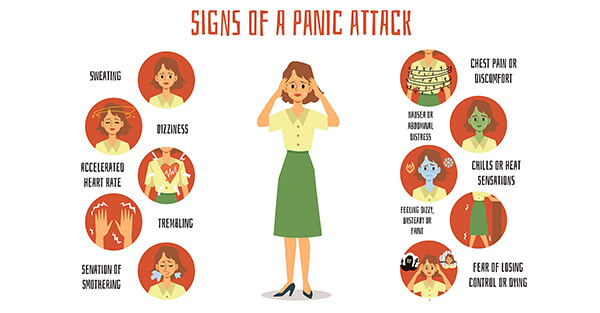What is a Panic Attack?
Panic attacks are more common than we think. Roughly one in five people will experience a panic attack at some point. Panic attacks can be debilitating and often lead to more serious mental health issues like anxiety and depression. A panic attack is not just a physical reaction but also involves the psychological and emotional effects of the condition. When experiencing a panic attack, it cannot be easy to reason and stay calm. Suppose you or someone you know is experiencing these symptoms. In that case, it’s essential to seek help from a medical professional specializing in CBT or other forms of therapy that help reduce the severity of the condition. CBT is an effective treatment for panic attacks because it helps people recognize their thoughts as they occur without judgment while providing them with strategies they can use to combat Treatment for panic attacks. CBT often incorporates mindfulness and breathing exercises to help people manage symptoms.

Options Of Treatment for Panic Attacks
Panic attacks are a common fear that many people experience. They are also quite common in people with anxiety disorders.
Panic attacks can be treated with medication, therapy, or both. The most effective treatment for panic attacks is cognitive behavioral therapy (CBT). It is recommended that you try CBT before any other treatment option. Treatment for panic attacks includes:
- Medication
- Therapy
- Self-help books and programs
- Psychotherapy
- Support groups
- Breathing exercises
- Yoga
Best Treatment For Panic Attack- CBT
Cognitive behavioral therapy is a form of psychotherapy that helps people overcome negative thinking patterns and make better choices in their actions and behaviors. It often uses cognitive restructuring, which refers to the process of challenging distorted thoughts.
The main goal of CBT is to help the client gain insight into how their thoughts affect them, so they can make changes to improve their situation.
CBT therapists often encourage patients to think positively and focus on their strengths rather than dwelling on their weaknesses.
CBT has been shown to effectively reduce panic disorder symptoms, which can lead to lower self-esteem and self-defeating beliefs. This therapy helps people learn how to change their thinking patterns and behaviors. It also helps them cope with stress, anxiety,, and depression by teaching them mindfulness, stress management, and problem-solving skills.
Symptoms associated with a Panic Attack

Panic attacks are anxiety disorders characterized by various physical and emotional symptoms that can cause distress and lead to fear.
One of the most distressing symptoms is shortness of breath. It can occur in both panic attacks and anxiety disorders. It often leads to fear, which then leads to more panic attacks.
Shortness of breath is one symptom that leads people to believe they are dying or losing control during an attack. The other most common somatic symptoms are chest pain and excessive sweating. These symptoms lead to losing control and dying.
These panic attack fears lead to agoraphobia which is another different condition. Agoraphobia occurs through cognitive fusion when one stimulus leads to another without a break. For example, if you are afraid of heights, you will start to avoid any situation where you might encounter heights, like walking on a bridge or driving over an overpass. With these avoidance behaviors reinforcing your fears, your phobias become stronger and stronger over time.
There are various treatments for agoraphobia that can help people overcome their fears and return to their everyday lives again.
Understanding The CBT Process
CBT is a widespread mental health treatment effective in treating depression, anxiety, and other disorders. The CBT process consists of three phases: assessment, treatment, and relapse prevention. The initial phase is the assessment phase. During this phase, the therapist gathers information about the client’s situation and history. This information helps the therapist to determine what kind of treatment will be most effective for them.
The CBT process goes through the following steps:

i. Recognize when you have negative thoughts
Negative thought patterns can be hard to break, but they are manageable with the help of a therapist and the CBT process.
ii. Replace negative thoughts with positive ones
CBT starts with the therapist assigning homework activities to the patient. The therapist would then help the patient replace these unhealthy ways of thinking with healthier habits. The process allows the client to identify and replace faulty thoughts with positive ones. The process involves challenging harmful ideas that may push a person into depression and anxiety.
iii. Practice new thoughts through exercise
The CBT process includes the therapist assigning activities, exercises, and healthy thought practices. These activities help the patient recognize their triggers and how they can control them to be more positive.
iv. Writing Exercises
The CBT Writing Exercises are a series of exercises that help you to identify and change your negative thoughts, behaviors, and emotions.
The CBT Writing Exercises are a group of exercises that help you to identify and change your negative thoughts, behaviors, and emotions. The activities are based on cognitive behavioral therapy (CBT). They can be used for anxiety, depression, self-esteem issues, or other mental health issues.
Some joint CBT writing exercises include journal writing, keeping a gratitude journal, and using affirmations.
v. Skill building And Behavioral Changes
Cognitive behavioral therapy is a type of psychotherapy that focuses on the relationship between thoughts, feelings, and behaviors. It is an effective way to help people learn skills to reduce stress and cope with difficult situations. It includes skills to reduce stress, practicing the behavior, and healthy coping strategies.
vi. Desensitization
One way CBT therapists can help their clients manage their feelings of anxiety is through desensitization. This is when the therapist gradually introduces the client to anxiety-producing stimuli while teaching him how to manage his feelings of anxiety.
Desensitization effectively reduces symptoms for many people with panic and other anxiety disorders.
vii. Relaxation Techniques
One of the essential skills in your arsenal is the ability to relax. There are many ways to do so, but one of the most effective methods is Cognitive Behavioral Therapy (CBT).
CBT is a form of psychological treatment that helps people with anxiety, depression, phobias, and substance abuse problems. It changes thoughts and behaviors by modifying how people think about a situation or event.
The following are some relaxation techniques that you can use during CBT sessions:
Progressive muscle relaxation: This technique involves tensing and then relaxing different muscle groups in your body; for example, tensing your left arm and then slowly releasing it down until it’s at rest.
Deep breathing: Inhaling deeply through your nose It is not uncommon for people to experience panic attacks and the best way to deal with them is by seeking professional help from a psychiatrist. The best treatment for panic attacks
is available in online therapy, phone therapy, or in-person consultations. Seeking professional help by talking to a psychiatrist can help you rebuild your life and learn how to deal with panic attacks.
